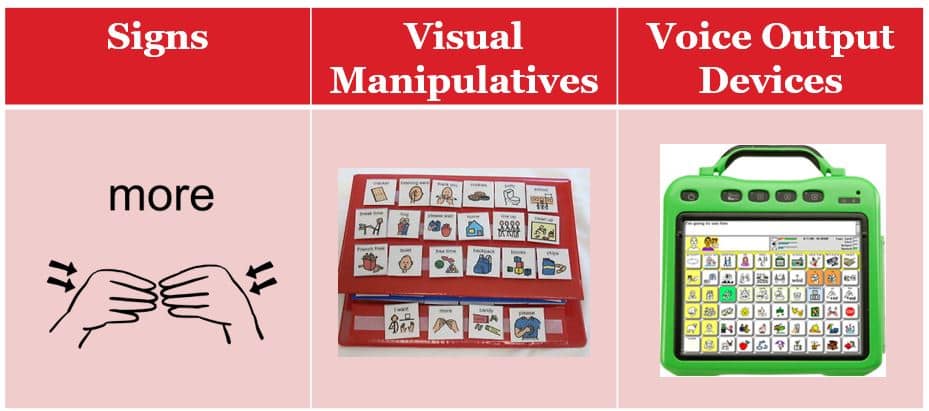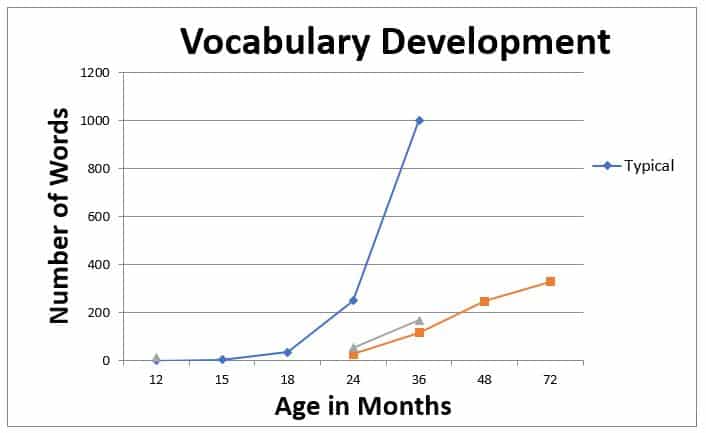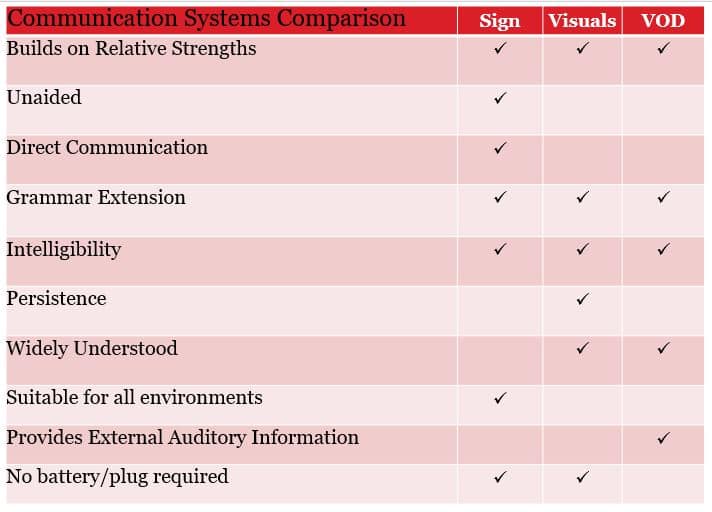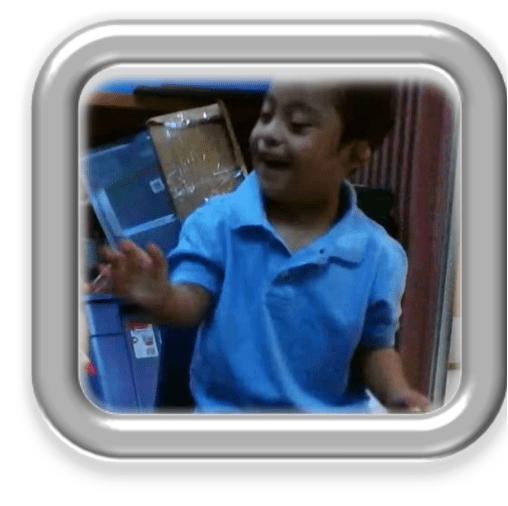What do we do when disorders like Apraxia and Down Syndrome severely limit what a child is able to tell us? It is so frustrating for them because there is still so much that they want to get across but motor constraints and/or intellectual limitations have a negative impact on their ability to express themselves. Debates rage about what is the best way to serve them. Is it signs, symbols, or a device? Parents and teachers are often at a loss and rely on our guidance. The good news is that we don’t have to choose. We can use Total Communication, which uses all modalities to get great results.
Total Communication is a speech therapy strategy that teaches multiple communication modalities, such as signing, pointing, and augmentative devices to increase communication. Rather than choosing one approach, total communication counts all modalities used towards utterance length.
Let’s talk about some research supporting total communication, show the pros and cons of each modality, and then show how to incorporate all three so that children with severe communication needs have multiple tools to fall back on.

Defining Therapy Strategy Types That Can Make Up Total Communication
Children who have diagnoses like Apraxia and Down Syndrome are truly unique in the way that they communicate and interact. Speech therapy can often be difficult because these situations involve so many different developmental domains. Down syndrome for example, can often include anatomical and physical differences, such as low tone and a high, narrow palette relative to tongue size. Typically, there could be a high desire for social emotional interaction. Motor planning limitations, weak posture and low strength can occur. At the same time a child can have a highly functional vocabulary of gestures. Strong receptive language skills are often common alongside limited expressive language, and there can also be reduced or fluctuating hearing.
These populations are unique, yet common to our caseloads. Thus, it makes sense that there would be a therapeutic strategy that take these limitations into consideration.
This is where total communication comes in. Total communication basically means giving therapy through verbal and other modalities, such as visual, auditory, kinesthetic, and tactile awareness. This could include signing, visual, manipulative, as well as voice output devices. The point is that many communication strategies, when used together, produce much greater results.
And here’s why: in studies of vocabulary, children with Down Syndrome not only experience a later start to vocabulary acquisition, but slower growth over time. With regards to language development, early milestones are nearly equal, while typically developing peers develop rapidly after 12 months.

Total communication ensures that children are exposed to multiple modalities during learning, including visual auditory, kinesthetic, and tactile methods. The total communication approach includes verbalization paired with an additional communication system that builds on these modalities of learning. And it also builds on the strength of receptive language.
Visual Manipulatives – Pros and Cons
Visual manipulatives can be used with many children with a variety of disabilities. Most of us are familiar with PECS (picture exchange communication systems) which are great because they do not require the person to be familiar with the system itself in order to communicate with the child relying on the PECS. A great advantage of visual manipulatives is that they can include nouns, verbs, adjectives, and prepositions to create sentence strips to increase the length of utterances produced.
Implementing a visual manipulative system in the school can be challenging because of the fact that it is an aided form of communication. Also when introducing new concepts, teachers and parents or speech pathologists must prepare visuals in advance in order to make language available to the student using the system. Also, children using visual manipulatives must have their picture vocabulary available to them at all times. This may include carrying around a binder, which may not always be practical, especially in places such as the playground.
| Visual Manipulatives Pros | Visual Manipulatives Cons |
|---|---|
| Teaches persistence | Aided |
| Widely understood | Requires additional prep time |
| Grammar extension | Not suitable for all environments |
Voice Output Devices – Pros and Cons
Voice output devices (VOD) can range in complexity from a single switch or a single button to a complex system involving thousands of vocabulary words. There’s auditory feedback when you push the button which can increase complexity as a child becomes more proficient with this type of system. Similar to a visual manipulative system, voice output devices can be understood by a wide audience which increases when auditory functions are used.
The challenge of implementing a VOD system in the school is that, like a visual manipulative system, it’s an aided form of communication, meaning that the child has to have their device with them at all times. Unlike a visual manipulative system, it requires charged batteries in order to function properly. It can be frustrating to have a lesson all planned out and to have your visuals ready, only to have the device die. An additional downfall of a voice output device is that teachers, parents, and speech pathologists need to spend additional time programming devices. It can be hard to keep up with the vocabulary if the student is a quick learner.
| Voice Output Device Pros | Voice Output Device Cons |
|---|---|
| Widely understood | Aided |
| Provides auditory and visual information | Requires battery |
| Range of complexity of devices | Prep time |
| Grammar extension | Not suitable for all environments |
Signing– Pros and Cons
Sign language is a quick way to introduce communication and give a child a way to let us know what they want and need. There is no device or object needed to communicate so communication can take place naturally in any environment. It also builds on strengths that a child already has because most students begin communicating with gestures.
The ability for children with non-verbal communication who sign to communicate with others is limited by the communication partner’s knowledge of sign language. Given that we know that they interact with numerous peers and adults, this challenge may arise frequently for students. Additionally, if children have difficulty with the fine motor skills necessary to produce certain signs, they may not be understood even to people familiar with sign language.
| Signing Pros | Signing Cons |
|---|---|
| Reduces frustration | Limited to communication partner’s knowledge |
| Easier to learn | Ambiguous gestures |
| Builds on relative strengths | |
| Unaided | |
| Direct Communication | |
| Pragmatic skills |
A Quick Note on Parent Buy-In for Signing
Often when we suggest that we could use sign language as a communication system, parents are worried that their child is not going to develop verbal speech. However, studies have shown that sign language does not hinder a child’s ability to develop spoken language. Sign is often abandoned or phased out as verbal vocabulary increases. Share this idea with your parents and talk instead of signing being a “bridge” between non-verbal and verbal communication.
These interactions go much better when the focus of the conversation is on reducing frustration. With Down Syndrome for example, the lack of neurological and fine motor abilities to produce spoken words and behavioral challenges can arise due to frustration and not being able to communicate their basic wants and needs.
Signing has been noted to reduce this frustration in young children and allow them to have a functional way to communicate. And for most children with Down Syndrome, sign language seems like a natural segue into communication because it addresses the Primary Down Syndrome Characteristics that Impact Communication. Given their known strengths in the areas of visual facial and visual motor skills, children with Down Syndrome use many more gestures in general when compared to typically developing children with the same lexical comprehension.
In terms of the school setting, the use of sign language can be practical as it’s an unaided form of communication, meaning that it does not require any devices or objects. Also, children who use sign language are able to directly communicate with their partner instead of communicating through the use of an object. This builds on their strengths, their social interaction, and helps to develop pragmatic skills such as eye gaze and turn-taking.
Comparing Types of Total Communication
Here is a chart that provides a quick comparison of the features of each communication system. We can see that they all build on relative strengths. They all allow for grammar extension and they all can increase intelligibility. So regardless of what system is chosen, they will all improve communication, but they also all have their own limitations. So why not give a child the ability to use all of them?

I think the take home message is that it is important to have the ability to use any tool to promote communication, depending on the situation and the needs of the child. And when deciding on an appropriate communication system, it’s important to keep in mind the child’s daily routine and the people that he or she interacts with on a day-to-day basis.
Let’s End with a Total Communication Example:

If a child with Down Syndrome comes from an early childhood intervention program where the use of signing has been implemented and adopted by the child’s family, it’s important to support the use of that communication system in the school environment as well. However, that’s not to say that sign will be the only communication system that’s used. A total communication approach can be the most effective for students learning new vocabulary in a variety of settings.
So this means always pairing verbalization with the communication system. Clinical research has shown that when intervention is aligned with school curriculum, students are more successful at retaining and generalizing communication skills learned in therapy.
If you want to learn more about how to apply Total Communication to your therapy, check out this short video.



